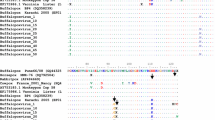Summary
The diagnostic characteristics of four poxviruses isolated from infected Indian buffaloes have been determined. Three isolates were all very similar, differing in only minor properties. They were serologically indistinguishable from vaccinia virus and had the same ceiling temperature as it, and we regard them as slightly different strains of vaccinia virus. The fourth isolate could be clearly differentiated from the other three, and also from existing members of the vaccinia-variola subgroup, and it is suggested that it be called buffalopox virus.
Similar content being viewed by others
References
Andrewes, C., andH. G. Pereira: Viruses of Vertebrates. 2nd Ed., p. 320. London: Ballière, Tindall, and Cassell, 1967.
Baxby, D.: Variability in the characteristics of pocks produced on the chick chorioallantois by white pock mutants of cowpox and other poxviruses. J. Hyg. (Lond.)67, 637–647 (1969).
Baxby, D., andC. J. M. Rondle: The inhibition of growth of vaccinia and cowpox viruses in RK 13 cells. J. Hyg. (Lond.)66, 191–205 (1968).
Bedson, H. S., andK. R. Dumbell: The effect of temperature on the growth of pox viruses in the chick embryo. J. Hyg. (Lond.)59, 457–468 (1961).
Bedson, H. S., andK. R. Dumbell: Smallpox and Vaccinia. Brit. med. Bull.23, 119–123 (1967).
Bhatia, S. N.: Variola on the ears and round the eyes of buffaloes. Indian vet. J.12, 236–237 (1936).
Boulter, E. A.: The titration of vaccinial neutralizing antibody on chorioallantoic membranes. J. Hyg. (Lond.)55, 502–512 (1957).
Douglas, H. W., C. J. M. Rondle, andB. L. Williams: Microelectrophoresis of cowpox and vaccinia viruses in molar sucrose. J. gen. Microbiol.42, 107–113 (1966).
Downie, A. W., andK. R. Dumbell: Pox viruses. Ann. Rev. Microbiol.10, 237–252 (1956).
Downie, A. W., andC. H. Kempe: Poxviruses. In: Diagnostic Procedures for Viral and Rickettsial Infections, pp. 281–320. New York: Amer. publ. Hlth. Ass., 1969.
Downie, A. W., andK. McCarthy: The viruses of variola, vaccinia, cowpox and ectromelia—neutralization tests on the chorioallantois with unabsorbed and absorbed immune serum. Brit. J. exp. Path.31, 789–796 (1950).
Dumbell, K. R.: Laboratory aids to the control of smallpox in countries where the disease is not endemic. Progr. med. Virol.10, 388–397 (1968).
Fenner, F.: The biological properties of several strains of vaccinia, cowpox and rabbitpox viruses. Virology,5, 502–529 (1957).
Fenner, F., andF. M. Burnet: A short description of poxvirus group (vaccinia and related viruses). Virology4, 305–314 (1957).
Gispen, R.: Analysis of poxvirus antigens by means of double-diffusion. A method for direct serological differentiation of cowpox. J. Immunol.74, 134–141 (1955).
Hobday, T. L., A. R. Rao, C. H. Kempe, andA. W. Downie: Comparison of dried vaccine with fresh Indian buffalo-calf lymph in revaccination against smallpox. Bull. Wld Hlth Org.25, 69–71 (1961).
Kaplan, C.: Heat inactivation of vaccinia virus. J. gen. Microbiol.18, 58–63 (1958).
Maltseva, N. N., E. M. Akatova-Shelukhina, M. A., Yumasheva, andS. S. Marennikova: The aetiology of epizootics of certain smallpox-like infections in cattle, and methods of differentiating vaccinia, cowpox and swinepox viruses. J. Hyg. Epidem. (Praha)10, 202–209 (1966).
Mathew, T.: Virus study of pox disease among buffalo. Ind. J. Path. Bact.10, 101–102 (1967).
McCarthy, K., andK. R. Dumbell: Chorioallantoic inoculation of eggs-an improved method. Virology14, 488–489 (1961).
McNeill, T. A.: The neutralization of poxviruses. II. Relationships between vaccinia, rabbitpox, cowpox and ectromelia. J. Hyg. (Lond.)66, 549–555 (1968).
Reed, L. J., andH. Muench: A simple method of estimating fifty per cent endpoints. Amer. J. Hyg.27, 493–497 (1938).
Rondle, C. J. M., andK. R. Dumbell: Antigens of cowpox virus. J. Hyg. (Lond.)60, 41–49 (1962).
Rondle, C. J. M., andJ. D. Williamson: Studies on the LS antigen of vaccinia virus. J. Hyg. (Lond.)66, 415–426 (1968).
Sharma, G. K.: An interesting outbreak of variola vaccinia in Lahore. Miscellaneous Bull. Imp. Counc. Agric. Res. Selected articles No. 8, 1–4 (1934).
Singh, I. P., andS. B. Singh: Isolation and characterization of the aetiologic agent of buffalopox. J. Res. Ludhiana4, 440–448 (1967).
Wariyar, K. C.: Variola in buffaloes. Ind. vet. J.14, 169–170 (1937).
Author information
Authors and Affiliations
Rights and permissions
About this article
Cite this article
Baxby, D., Hill, B.J. Characteristics of a new poxvirus isolated from indian buffaloes. Archiv f Virusforschung 35, 70–79 (1971). https://doi.org/10.1007/BF01249754
Received:
Issue Date:
DOI: https://doi.org/10.1007/BF01249754




